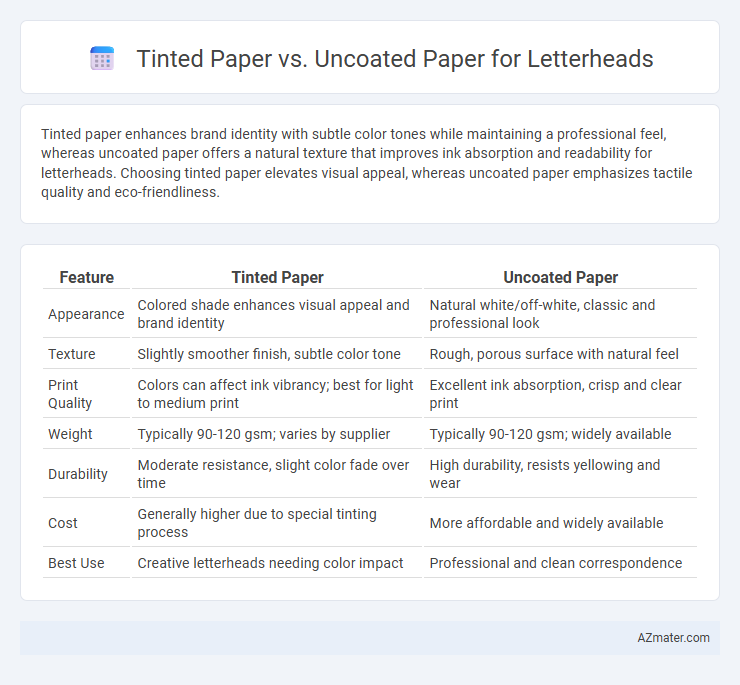Tinted paper enhances brand identity with subtle color tones while maintaining a professional feel, whereas uncoated paper offers a natural texture that improves ink absorption and readability for letterheads. Choosing tinted paper elevates visual appeal, whereas uncoated paper emphasizes tactile quality and eco-friendliness.
Table of Comparison
| Feature | Tinted Paper | Uncoated Paper |
|---|---|---|
| Appearance | Colored shade enhances visual appeal and brand identity | Natural white/off-white, classic and professional look |
| Texture | Slightly smoother finish, subtle color tone | Rough, porous surface with natural feel |
| Print Quality | Colors can affect ink vibrancy; best for light to medium print | Excellent ink absorption, crisp and clear print |
| Weight | Typically 90-120 gsm; varies by supplier | Typically 90-120 gsm; widely available |
| Durability | Moderate resistance, slight color fade over time | High durability, resists yellowing and wear |
| Cost | Generally higher due to special tinting process | More affordable and widely available |
| Best Use | Creative letterheads needing color impact | Professional and clean correspondence |
Introduction to Letterhead Paper Choices
Tinted paper for letterhead offers enhanced visual appeal and brand differentiation through subtle color variations that attract attention and elevate professional presentation. Uncoated paper provides a natural texture and excellent ink absorption, creating a classic, tactile feel ideal for traditional business correspondence. Selecting between tinted and uncoated paper depends on the desired aesthetic impact, print clarity, and brand identity alignment in letterhead design.
What is Tinted Paper?
Tinted paper is a type of specialty paper that features a subtle color tint, often used to enhance the visual appeal and professionalism of letterhead stationery. Unlike uncoated paper, which is plain and natural in appearance, tinted paper adds a soft background hue that can make text and logos stand out more effectively while maintaining a refined texture. This paper choice can influence brand perception by providing a distinctive and elegant look for corporate communications.
What is Uncoated Paper?
Uncoated paper for letterheads is a type of paper that lacks a smooth, glossy finish, offering a natural, textured surface that enhances ink absorption and readability. This paper is often preferred for its organic feel, professional appearance, and excellent compatibility with various printing techniques such as offset and digital printing. Unlike tinted paper, uncoated paper maintains a clean, white background that ensures text clarity and color accuracy in corporate stationery.
Visual Appeal: Tinted vs Uncoated Letterhead
Tinted paper for letterheads offers a distinct visual appeal with subtle hues that enhance branding and draw attention, making printed materials stand out in a stack. Uncoated paper delivers a natural, matte finish that imparts a professional and timeless look, emphasizing readability and texture without distraction. Choosing tinted paper emphasizes creativity and uniqueness, while uncoated paper prioritizes classic sophistication and tactile quality.
Print Quality and Color Reproduction
Tinted paper for letterhead enhances visual appeal with subtle background hues that improve color contrast and vibrancy in print, making logos and text pop effectively. Uncoated paper offers a natural, matte finish that absorbs ink more, resulting in softer color reproduction and less sharpness, ideal for understated, professional aesthetics. Print quality on tinted paper benefits from reduced glare and improved readability, whereas uncoated paper excels in tactile feel but may require specialized inks to prevent color dulling.
Texture and Feel: Customer Perception
Tinted paper offers a distinctive texture that feels smoother and more polished, enhancing customer perception of sophistication and quality in letterheads. Uncoated paper provides a natural, slightly rough texture that conveys authenticity and tactile warmth, often preferred for artisanal or eco-friendly branding. The choice between tinted and uncoated paper directly influences the tactile experience, impacting how clients emotionally connect to the printed message.
Writing Experience on Tinted and Uncoated Paper
Writing on tinted paper offers a unique sensory experience by providing a smooth surface that reduces glare and eye strain, enhancing readability and comfort for extended writing sessions. Uncoated paper, with its natural texture and absorbency, allows ink to settle deeply, resulting in richer lines but may require slower drying times to prevent smudging. Both paper types impact pen glide and ink behavior differently, influencing overall writing satisfaction and presentation quality for letterheads.
Branding Impact and Professionalism
Tinted paper enhances branding impact by providing a unique visual identity that differentiates letterheads, making businesses more memorable and reinforcing brand colors consistently. Uncoated paper conveys professionalism with a clean, natural texture that projects authenticity and is often preferred for formal communications due to its classic and tactile quality. Both options support distinct branding strategies, with tinted paper emphasizing creativity and uncoated paper emphasizing traditional professionalism.
Cost Comparison: Tinted vs Uncoated Paper
Tinted paper for letterheads generally incurs higher costs due to specialized dyes and additional processing compared to uncoated paper, which is more affordable and widely available. Uncoated paper offers budget-friendly options while providing a natural, classic finish, making it ideal for cost-sensitive bulk printing. Evaluating print project volume and desired aesthetics helps determine the best cost-efficient choice between tinted and uncoated letterhead paper.
Choosing the Right Paper for Your Letterhead
Choosing the right paper for your letterhead impacts brand perception and readability, with tinted paper offering a subtle color that enhances uniqueness, while uncoated paper provides a natural texture promoting a classic, professional look. Tinted paper is ideal for businesses seeking to add a distinct visual element without compromising print clarity, whereas uncoated paper excels in delivering a tactile, professional finish that supports high-quality ink absorption. Consider the printing method and brand identity when selecting between tinted and uncoated paper to ensure your letterhead effectively communicates your message and stands out in correspondence.

Infographic: Tinted paper vs Uncoated paper for Letterhead
 azmater.com
azmater.com